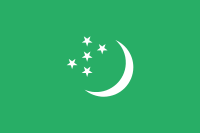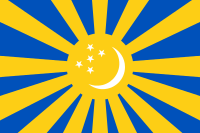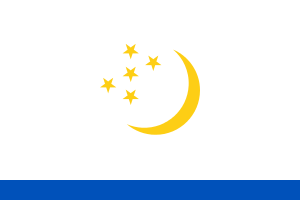Armed Forces of Turkmenistan
| Armed Forces of Turkmenistan | |
|---|---|
|
Türkmenistanyň Ýaragly Güýçleri Түркменистаның Йараглы Гүйчлери | |
 Roundel of Turkmenistan | |
| Founded | January 28, 1992 |
| Service branches |
Turkmen National Guard |
| Headquarters | 4 Galkynysh Street, Ashgabat[1] |
| Leadership | |
| President of Turkmenistan | Gurbanguly Berdimuhamedow |
| Minister of Defence | Major General Begench Gundogdyev |
| Chief of the General Staff | Ismail Ismailov[2] |
| Manpower | |
| Military age | 18[3] |
| Conscription | 24 months (IISS 2012) |
| Active personnel | 22,000 (Army 18,500, Air Force 3,000, Navy 500) |
| Reserve personnel | formerly 108,000, not since 2007 at least.[4] |
| Expenditures | |
| Budget | $198 million (FY10) (IISS 2012) |
| Percent of GDP | 3.4% (FY10)[3] |
| Industry | |
| Foreign suppliers |
|
| Related articles | |
| Ranks | Military ranks of Turkmenistan |
The Armed Forces of Turkmenistan (Turkmen: Türkmenistanyň Ýaragly Güýçleri, Түркменистаның Йараглы Гүйчлери) consists of an Army, Navy, Air and Air Defense Forces, Border Troops, and Internal Troops, and a National Guard. After the fall of the Soviet Union, significant elements of the Soviet Armed Forces Turkestan Military District remained on Turkmen soil, including several motor rifle divisions. In June 1992, the new Russian government signed a bilateral defence treaty with Turkmenistan, encouraging the new Turkmen government to create its own armed forces but stipulating that they were to be placed under joint command.[5]
The Library of Congress Country Studies said that 'the Treaty on Joint Measures signed by Russia and Turkmenistan in July 1992 provided for the Russian Federation to act as guarantor of Turkmenistan's security and made former Soviet army units in the republic the basis of the new national armed forces. The treaty stipulated that, apart from border troops and air force and air defense units remaining under Russian control, the entire armed forces would be under joint command, which would gradually devolve to exclusive command by Turkmenistan over a period of ten years. For a transitional period of five years, Russia would provide logistical support and pay Turkmenistan for the right to maintain special installations, while Turkmenistan would bear the costs of housing, utilities, and administration.'
The Centre for Analysis of Strategies and Technologies's Moscow Defence Brief said that '..[i]n 1992-1993 Turkmenistan attempted to create a small national armed force based on the former 52nd Army (Soviet Union), which was located in the country and depended on support from Russia. Of the 300 formations and units, numbering 110,000 people, 200 were transferred to the command of Turkmenistan, 70 remained under Russia's jurisdiction, and 30 were either withdrawn or demobilized.[6]
In 1994, the chief of staff and first deputy minister of defense was Major General Annamurat Soltanov, a career officer who had served in Cuba and Afghanistan; another deputy minister of defense, Major General Begdzhan Niyazov, had been a law enforcement administrator prior to his appointment. Russian commanders included Major General Viktor Zavarzin, chief of staff and first deputy commander of the Separate Combined-Arms Army of Turkmenistan, and commander of the Separate Combined-Arms Army of Turkmenistan and deputy minister of defense Lieutenant General Nikolai Kormiltsev. Russian Major General Vladislav Shunevich served together with Turkmen Major General Akmurad Kabulov as joint commanders of the border troops in the Turkmen Border Guard.
'..Turkmenistan consistently has refused to join multilateral CIS military groupings, but Russia maintains joint command of the three motorized rifle divisions in the Turkmenistani army. Under a 1993 bilateral military cooperation treaty, some 2,000 Russian officers serve in Turkmenistan on contract, and border forces (about 5,000 in 1995) are under joint Russian and Turkmenistani command. Altogether, about 11,000 Russian troops remained in Turkmenistan in mid-1996.'[7] From V.I. Feskov et al. 2013 and Michael Holm's data, it appears that the three divisions were the 58th, 88th, and 209th District Training Centre (former 61 Training MRD) at Ashkhabad. [8]
Jane's Information Group said in 2009 that "Turkmenistan's military is, even by the standards of Central Asia, poorly maintained and funded."[9]
State Security Council
General Staff
Structure
- Land Forces Command;
- Department of the Missile Forces and Artillery
- Department of the Air Force and Air Defense Forces Command
- Department of communication troops
- Department of Engineering Troops
- Department of training specialists for the Armed Forces of Turkmenistan;
- Department of specialized formations.
List of Chiefs of Staff
Ground Forces

.jpg)
.jpg)
.jpg)
.jpg)
The Turkmen military inherited several motor rifle divisions from the Soviet Armed Forces Turkestan Military District, forming the basis of the Turkmen ground forces. Among them was the 58th Motor Rifle Division at Kyzyl-Arvat.[10] Interim Russian commanders in the first half of the 1990s included Major General Viktor Zavarzin, chief of staff and first deputy commander of the Separate Combined-Arms Army of Turkmenistan, and commander of the Separate Combined-Arms Army of Turkmenistan and deputy minister of defence Lieutenant General Nikolai Kormiltsev.
Today the ground forces include the 2nd, 3rd, 11th, and 22nd Motor Rifle Divisions.[11] The 11th Motor Rifle Division is the former Soviet 88th Motor Rifle Division. The 11th (according to other sources 357th) MSD behalf of Sultan Sanjar (former Soviet 88th MSD; Kushka officially - Serhetabat).
It was reported in January 2007 that on the Caspian Sea and the coastal zone to a depth of 350 kilometers, and on the Turkmen-Iranian border is located about 90% of the Army (22nd Motorized Division on the Caspian coast, 2nd and 3rd motorized divisions on the Turkmen-Iranian border, 11th Motorized Division on the Tajik-Afghan border).[12]
The military ranks have reverted to traditional names and structure, and are now:
- Esger - warrior
- Onbashi - leader of 10 (section leader)
- Yuzbashi - leader of 100 (junior officer)
- Munbashi - leader of 1000 (senior officer)
- Goshunbashi - Army commander
The rank of a marshal has also apparently been reintroduced.[13] The real cash payment to the warrior rank in the army is about US$1.5 - 3 (2005 rates) per month. Only some of the conscript's time in the military is occupied with military service, the rest being occupied with "labour" (half a day) and "self-improvement" (2–3 hours a day) by reciting traditional Turkoman texts, learning songs and playing music.
Equipment
The number of vehicles is around 2,000, the number of tanks is around 700 and the number of artillery pieces is around 560.[14]
Turkmen ground forces equipment includes 702 T-72,[15] and 10 T-90, ordered in 2009 for approximately $30 million.[16][17]
AIFV / APC include BTR-60/BTR-70/BTR-80 - 829,[15] BMP-1/BMP-2 - 930,[15] BRM-1 12, and BRDM-2 - 170.
Artillery
Self-Propelled
- 2S1 Gvozdika - 40
- 2S3 Akatsiya - 16
- 2S9 Nona - 12
Multiple launch Rocket Systems
- BM-21 Grad - 56
- BM-27 Uragan - 54
- BM-30 Smerch - 6 on order[18]
Towed Guns
- D-30 122mm Gun - 180
- D-1 152mm Gun - 17
- 2A65 152mm Gun - 72
Mortars
- M-37M 82mm mortar - 31
- PM-38 120mm mortar - 66
Air Defence Guns
- ZSU-23-4 - 48
- 57 mm AZP S-60 - 22
Surface to Air Missiles
- S-125 Neva/Pechora - ?
- 2K12 Kub - 2
- 9K33 Osa - 40
- 9K35 Strela-10 - 13
Light equipment
Air Force


.jpg)
The IISS in 2012 said the Air Force had 3,000 personnel with 94 combat capable aircraft.[19] The total number of aircraft is around 120.[14] It said there were two fighter/ground attack squadrons with MiG-29/MiG-29UB (total of 24 both types), Sukhoi Su-17 Fitter-Bs (65) and two Sukhoi Su-25 Frogfoots (with 41 more being refurbished). It reported one transport squadron with Antonov An-26 'Curl' (1), and Mi-8s and Mi-24s (8 and 10 listed in service respectively). Training units had Sukhoi Su-7 Fitter-As (3 listed in service) and L-39 Albatross. Air defence missile units had SA-2, SA-3, and SA-5.
Units:
- 99th Aviation Base (former 67th Mixed Aviation Regiment) (Mary-2 airbase) with MiG-29 and Su-25.[20]
- 47th Separate Mixed Aviation Squadron (Аk-Tepe/Ashkabad) with Аn-26/24, Mi-24 and Mi-8.
- 107th Fighter Aviation Regiment (Ak-Tepe) with 38 MiG-23 and 20 MiG-25 (not operational).
- 31st Separate Aviation Squadron (Chardzhou/Turkmenabad) with MiG-21, Su-7, L-39, Yak-28 and Аn-12 (not operational). Former 366th Independent Helicopter Squadron.
- 55th Fighter Aviation Regiment (Balkanabat) with MiG-23М (not operational). Former 179th Fighter Aviation Regiment.
- 56th Storage Base (Kyzyl-Arvat) with MiG-23. Former 217th Fighter/Bomber Aviation Regiment.
- 1st Anti-Aircraft Missile Regiment 'Turkmenbashi' (Bikrova/Ashkabad) with 2K11 Krug.
- 2nd Radio-Technical Brigade.
Aircraft
Current inventory
| Aircraft | Origin | Type | Variant | In service | Notes | |
|---|---|---|---|---|---|---|
| Combat Aircraft | ||||||
| MiG-29 | Russia | multirole | 24[21] | |||
| Su-25 | Russia | attack | 20[21] | |||
| Transport | ||||||
| An-26 | Ukraine | transport | 1[21] | |||
| An-74 | Ukraine | heavy transport | 2[21] | |||
| Helicopters | ||||||
| Mil Mi-17 | Russia | utility | 15[21] | |||
| Mil Mi-24 | Russia | attack | 10[21] | |||
| AgustaWestland AW109 | Italy | attack / utility | 3+[22] | |||
Border Guard
Naval Forces

Turkmen naval forces are currently directed by the Border Guard Service and consist of around 700 servicemen and sixteen patrol boats.[23] The Congressional Research Service, citing the International Institute for Strategic Studies, reports a number of six patrol boats.[14]
The International Institute for Strategic Studies reported in 2007 that Turkmenistan intended to form a navy and had a minor base at Turkmenbashy with one USCG Point class cutter and five Kalkan-class patrol vessels.[15] Jane's Fighting Ships 2001-2002 reported that the Point-class cutter was the Merjin, PB-129, (ex Point Jackson, 82378), which was transferred on 30 May 2000.
The country acquired four missile boats in 2011.[14] In 2014 they acquired 10 Tuzla-class patrol boats which were all delivered by 2015.
In 2012, Turkmenistan announced its first naval exercises in the Caspian Sea programmed for early September. Named Khazar-2012 (Khazar is the Persian name of the Caspian Sea), these tactical exercises came after a summer of somewhat heightened tensions with Azerbaijan over natural gas fields in a contested part of the sea.[24]
Ranks
- General of the Army[25]
- Colonel General
- Lieutenant General
- Major General
- Colonel
- Lieutenant-Colonel
- Major
- Captain
- Senior Lieutenant
- Lieutenant
- Junior Lieutenant
NCOs and Enlisted
- Chief Warrant Officer
- Warrant Officer
- Master Sergeant
- Senior Sergeant
- Sergeant
- Junior Sergeant
- Corporal
- Private
.jpg)
Military Academies
- Military Academy of Turkmenistan
- Military Institute of the Ministry of Defense of Turkmenistan
- Turkmen State Border Service Institute
- Institute of the Ministry of Internal Affairs of Turkmenistan
- Turkmen Police Academy
- Turkmen National Security Institute
- Turkmen Naval Institute
- Berdimuhamed Annayev 1st Specialized Military School of the Ministry of Defence of Turkmenistan
References
- ↑ Military Technology, World Defence Almanac 2008, p.255
- ↑ "ИСМАИЛОВ Исмаил - ЦентрАзия". CentrAsia.
- 1 2 "Turkmenistan Military 2014, CIA World Factbook". Retrieved 24 December 2014.
- ↑ John Pike. "Turkmenistan- Army". Retrieved 24 December 2014.
- ↑ Stephen Foye, 'Russian-Turkmen Defense Accord,' RFE/RL Daily Report, no. 109, (10 June 1992), p.1, via Janne E. Nolan (ed.), Global Engagement, Brookings, Washington D.C., 1994, p.369.
- ↑ Colonel Oleg BELOSLUDTSEV, Candidate of Historical Sciences, and Colonel Alexander GRIBOVSKY, Russia's Military-Political Relations with Kyrgyzstan, Tajikistan and Turkmenistan, Center for Analysis of Strategies and Technologies, accessed at http://mdb.cast.ru/mdb/3-2002/at/rmpr/, October 2015.
- ↑ Glenn E. Curtis (ed.), Russia: A Country study, Federal Research Division, Library of Congress, research completed July 1996 (Chapter 9)
- ↑ http://www.ww2.dk/new/army/corps/36ak.htm, and http://www.ww2.dk/new/army/gkv/turkvo.htm
- ↑ Josh Kucera, 'Centre of Attention: Central Asia,' Jane's Defence Weekly, 14 October 2009
- ↑ "58th Motorised Rifle Division". ww2.dk. Retrieved 8 October 2015.
- ↑ Brinkster.com
- ↑ http://www.polit.ru/analytics/2007/01/03/kavkaz.html, translated from Russian by Google Translate, July 2009
- ↑ Игорь Елков, Вся постсоветская рать: Какая из бывших советских республик всех сильнее, Российская газета - Неделя №3893 от 7 октября 2005 г.
- 1 2 3 4 Jim Nichol (Congressional Research Service) (16 May 2011). "Turkmenistan: Recent Developments and U.S. Interests" (PDF). fas.org. Retrieved 24 July 2012.
- 1 2 3 4 IISS (2007). The Military Balance 2007. London: Routledge for the IISS. pp. 326–327. ISBN 978-1-85743-437-8.
- ↑ "EurasiaNet News Briefs - Turkmenistan: Berdymukhamedov Mulls Russian Hi-Tech Deals". Eurasianet.org. 9 December 2009. Retrieved 2010-02-07.
- ↑ "Procurement (Turkmenistan) - Sentinel Security Assessment - Russia And The CIS". Janes.com. 21 October 2009. Retrieved 2010-02-07.
- ↑ http://www.defensenews.com/story.php?i=3600387&c=EUR&s=LAN
- ↑ IISS 2012 p.290
- ↑ Vad777, Turkmenistan Archived 8 February 2012 at the Wayback Machine.
- 1 2 3 4 5 6 "World Air Forces 2015 pg. 31". Flightglobal Insight. 2015. Retrieved 19 June 2015.
- ↑ Dominguez, Gabriel; Gibson, Neil (4 August 2017). "Turkmenistan releases footage of AW109 helos conducting live-fire drill". IHS Jane's 360. Archived from the original on 4 August 2017. Retrieved 4 August 2017.
- ↑ "Defense & Security Intelligence & Analysis: IHS Jane's". Retrieved 24 December 2014.
- ↑ "The First Naval Exercises of Turkmenistan in the Caspian Sea". The Gazette of Central Asia. Satrapia. 30 August 2012. Retrieved 30 August 2012.
- ↑ Administrator. "Turkmenistan army ranks military combat field uniforms dress grades uniformes combat Turkménistan | Turkmenistan army military ranks combat uniforms | Turkmenistan army military equipment vehicle UK". www.armyrecognition.com. Retrieved 2017-08-14.
- CIA World Factbook, 2003 edition.
Further reading
- Allison, Roy: Military Forces in the Soviet Successor States, Adelphi Paper No. 280 (London: IISS, 1993).
- Staar, Richard Felix: The new military in Russia: Ten myths that shape the image, Naval Institute Press, 1996.